There’s been a long-overdue sea change in marketing: Customers are now in control of the relationships with brands, not vice versa. They have high expectations for brand transparency and minimal patience for subpar experiences. Customers who are not satisfied go to other brands fast. You have to live up to their expectations if you want devoted and long-lasting clients. While your brand’s ability to provide highly relevant, contextual, and tailored experiences is necessary to build long-lasting relationships with today’s customers, trust is an equally important component that cannot be disregarded. Customers won’t do business with you if they don’t trust your brand. Being transparent with customers is the first step towards gaining their trust and, eventually their loyalty. Transparent brands are, therefore, crucial if you want to boost customer loyalty.
This article will discuss what transparent brands are about, why they matter, their benefits, and what we can learn from them.
Key Points
- Transparent brands prioritize openness and honesty in business practices, communications, and interactions with customers, employees, and other stakeholders.
- Some benefits of transparent brands include building trust and loyalty, providing a serious competitive advantage, fostering employee engagement, cultural connection, and ownership and control.
- One way that transparent brands affect consumers’ behavior is through the perception of value.
- Examples of transparent brands include Zulu & Zephyr, Farmacy, H&M, Everlane, and Mate the Label.
- The future of brand transparency includes blockchain integration, consumer-driven initiatives, and digital marketing transparency.
What are Transparent Brands?
Transparent brands are businesses that prioritize openness and honesty in their business practices, communications, and interactions with customers, employees, and other stakeholders. It’s a broad term with weighty influence. It’s both tangible and not, concerned largely with a realness that drives customers to return repeatedly.
Transparency means different things to different brands, but at its core, a business is transparent when messaging is clear and authentic. This refers to any content and communication published by the brand, product, and policy information. Brands using models or influencers that reflect “real” people in marketing and advertising—and engaging with customers about it—exemplify brand transparency.
Transparent brands also appear in conversations about business practices. Brands that are willing to pull back the curtain to reveal decisions in areas like product development and diversity hiring are more likely to have increased customer trust. And trust matters—an Edelman survey concluded that 81% of buyers needed to trust a brand to buy from them.
According to many customer surveys and even comments on social media, brands must be transparent. Nearly three in four customers find transparency in communication crucial, particularly in a post-pandemic world.
Why Are Transparent Brands Important?: Why They Matter.

While information is at consumers’ fingertips, transparent brands have become more than just a buzzword; it’s necessary. Digitalization has empowered consumers, giving them access to vast information and enabling them to make informed decisions.
As a result, brands are under increased scrutiny, and their actions, values, and practices are being watched more closely than ever before. But why are transparent brands so important in today’s market?
#1. It Builds Trust and Loyalty
More and more often, your customers want to know what they’re buying. They don’t just care about the end product – they want a clear understanding of the values, processes, and intentions behind the brand they’re engaging with.
If you can be open about your mission, vision, and values and how they impact your operations and decisions, your customers will likely feel more confident in their choices. Why? Because this level of transparency creates a sense of authenticity and reliability that builds trusting, strong, long-lasting relationships.
From how you source your ingredients to fair pricing strategies, transparency presents a significant opportunity. When your customers know where their products are from, how they’re made, and why they’re priced at the RRP they’re at, they’ll feel much more connected to your brand.
#2. It Provides a Serious Competitive Advantage
Your customers are more informed – and more skeptical – than ever before. If you can be transparent about your operations and processes, you gain a significant competitive advantage over brands that aren’t.
Transparent brands differentiate themselves by openly sharing their values, processes, and business practices. This openness attracts customers who prioritize ethical and responsible brands and fosters loyalty among existing customers. Trust, once established, becomes a key driver for repeat business and brand advocacy.
Companies like Everlane and Warby Parker have successfully leveraged transparency as a key differentiator. Everlane’s “Radical Transparency” approach, where they disclose the true cost of their products and details about their factories, has resonated with consumers, leading to increased market share and brand equity. Similarly, Warby Parker’s openness about their pricing model and social mission has helped build a loyal customer base and elevate its brand status.
#3. Fosters Employee Engagement
A staff member with a true stake in the business and brand will be more likely to innovate, think and act outside the box, and invest more of their talent and time.
Brand transparency can encourage employee engagement by including staff in decision-making processes, clearly communicating changes and the reasons for those changes, and providing transparent performance review processes that genuinely support personal and professional development. An effective way to do this is by encouraging face-to-face meetings where non-verbal communication has a strong impact and personal connections are most easily cultivated. Another method is cross-department mentoring, which exposes employees to other departments and processes of the company.
#4. Cultural Connection
Big moments in culture often contribute to the desire for brand transparency. Black Lives Matter protests and conversations certainly influenced many brands to participate in the ongoing conversation about systemic racism, while the COVID-19 pandemic and the uncertainty it raised for millions of people brought brands into the fold, too. External factors like these impact brands, whether they engage with them or not.
The trend toward transparent brands started earlier in the 2010s because millennials became the driving buying force dictating how brands act and adapt, largely speaking more loudly about social and cultural matters that affect us all. In a mid-2010s report, compared to other consumers, 73% of millennial respondents were willing to pay extra for sustainable brands, and 81% said brands ought to make public declarations of corporate social responsibilities. In the almost decade since 83% of millennials still consider a brand’s value before supporting them with a purchase.
#5. Ownership and Control
One of the most important benefits of transparent brands is that they place total ownership and accountability in the hands of the business itself. When a brand is transparent about its values, processes, products, and goals, no one else can dictate to the company who it is or what it should be. In crisis management or in the face of bad feedback, the brand can fall back on transparency to clarify its position and messaging.
85% of customers say a brand’s history of transparency will make it more likely they will return after a bad experience. This is because people trust companies that are honest about mistakes and transparent in their processes to rectify them. Transparency as a core value is critical during difficult times and during periods of growth and success.
How Does Transparent Brands Affect Consumer Behavior?
When a brand is transparent, they are open and honest about their products, services, and business practices. This can include everything from the ingredients used in their products to their supply chain and manufacturing processes. By providing this information, brands can build customer trust, increasing loyalty and sales.
One way that transparent brands affect consumer behavior is through the perception of value. When a brand is transparent, consumers feel they get more for their money. They can see exactly what they are paying for and feel confident they are making a smart purchase. This can lead to increased sales and customer satisfaction.
Another way that transparent brands affect consumer behavior is through social responsibility. Consumers are increasingly concerned about the impact that their purchases have on the environment and society as a whole. When a brand is transparent about its sustainability efforts and social responsibility initiatives, it can attract consumers who are looking to make a positive impact with their purchases.
Brand transparency is an important factor in consumer behavior. It can increase trust, loyalty, and sales for brands that prioritize it. As consumers continue to demand more information and accountability from the brands they support, transparency will become even more important.
Where Do Transparent Brands Show Up?

It’s no secret that the internet—and social media—fundamentally changed the commerce game. Access to different cultures, perspectives, and ways of buying and selling impacts why we think the way we do and how we do business.
Social Media
Let’s start with social media. It is a bit of a figurative chicken and egg situation: Did a brand adapt because of something on social media, or did social trends change because of a brand?
The answer is both.
Instagram has over 1 billion active users, is expected to reach nearly 1.5 billion by 2025, and is most popular with those aged 25 to 34. Around 200 million brands are using Instagram. It’s the perfect medium for many brands to consider both professional and social conversations alongside the products they sell and even for selling their products right there in the app.
81% of people believe a brand needs to do something on social media to address current issues, yet only 15% believe brands are transparent about their approach.
Next, there’s TikTok. 43% of Gen Z buyers begin their buying journey on the app and it’s getting closer to one billion users as well, becoming the social media platform that more or less caters to consumer reviews (and scathing video essays and parody videos).
Brands must pivot strategies quickly because of how discourse and technology move. Today, people crave authentic interactions on social media. The global pandemic accelerated this trend around people’s experiences, signaling a massive shift away from aspirational content.
Social media has become an entry point for many into difficult conversations. Maintaining the status quo and focusing on brand voice only is no longer an option: buyers want their brands to be discerning and informed. Supporting every single cause is a no-go, lest they be viewed by buyers as inauthentic and opportunistic. Tackling what matters most to brand values encourages buyers to respond to it.
Read Also Social Media Etiquette: Best Practices
Fashion and Sustainability
Another key conversation is climate action. Sustainability is one of the most important topics for businesses worldwide. Yet, Vogue Business posited that transparency might be a dead end in fashion.
While looking at Fashion Revolution’s Transparency Index, sustainable efforts are tepid. Some brands are deploying manifestos that try to improve transparent communication with buyers on their sustainable practices. Transparency is necessary for holding brands accountable for more ethical practices, but it is simply surface-level if a brand decides to be selective on what it does or does not disclose.
Herein lies the quandary for many brands: it hurts the brand to be silent, but it also hurts them to be surface-level, and it might hurt them to disclose everything. As time goes on and cultural shifts inevitably occur, customers’ engagement and purchasing power will still likely align with a value system that matches their own, especially as Gen Z continues to reign.
It’s simply measuring risk. Do you include customers on the journey or not?
Examples of Transparent Brands
Before any attempt to purchase, customers want brands to actively take a look and communicate how they do their business. They want disclosures of struggles, past mistakes, and current opportunities for change. If the brand doesn’t do that, customers often dig for that information if transparency isn’t evident.
Here are some examples of transparent brands:
#1. Zulu & Zephyr
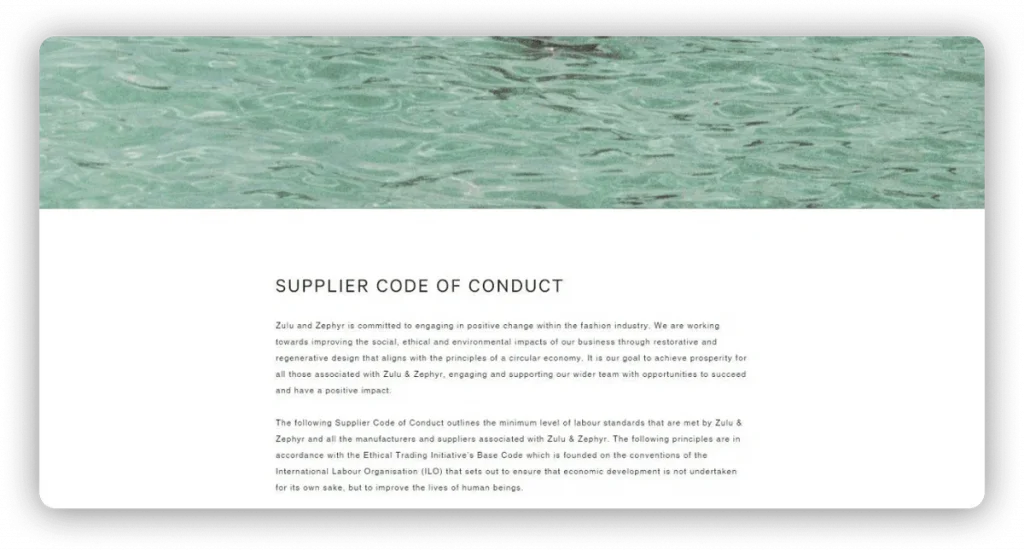
When visiting their website, the first thing you see on Zulu & Zephyr’s website is their Supplier Code of Conduct. This policy states they are committed to “positive change within the fashion industry” and are working to improve their business’s environmental, social, and ethical impacts through regenerative and restorative design. Their Code also meets the standards of the U.K.’s Modern Slavery Act since it outlines all the labor standards that Zulu & Zephyr and their manufacturers and suppliers meet.
#2. Farmacy
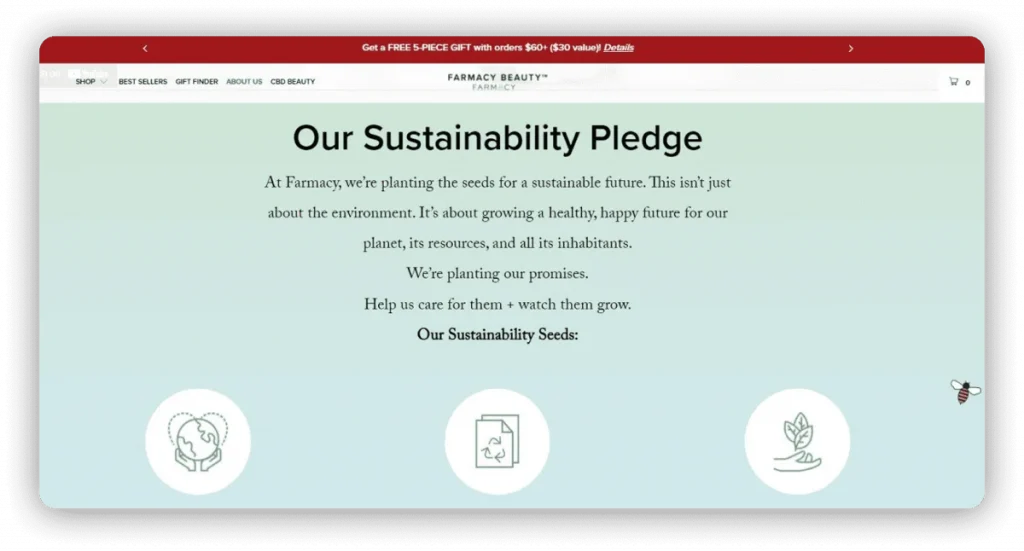
Farmacy is entirely transparent on its About Us page. According to their testimonials and videos, they’re a clean CBD company that doesn’t use mineral oils, formaldehyde, SLS SLES, and other chemicals you typically encounter in the industry. They also talk about their responsibility towards the Earth, how they’re a proud partner of Feeding America and detailed information about the environmental sustainability milestones they’ve achieved over the years.
#3. H&M

Fashion giant H&M has also made significant strides towards brand transparency. Their Sustainability page has videos and blogs detailing their commitment to a “greener” fashion future. Like the other transparent clothing brands we covered above, they also discuss their company vision, transparency goals, business standards, and strategies on their Leading the Change page. On their Transparency page, H&M discloses their supplier list and includes information about their products’ environmental and social impact.
#4. Everlane
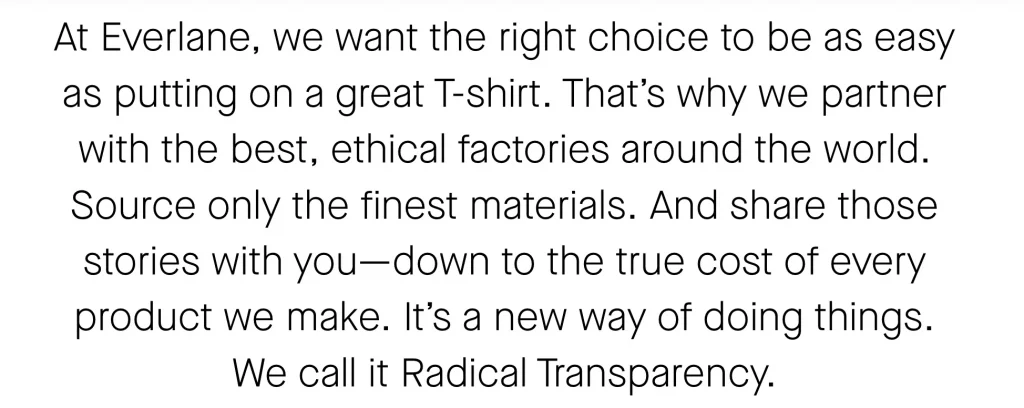
Embarking on a unique brand journey, Everlane, a clothing retailer, has been a transparent trailblazer. From the beginning, the brand shows a breakdown of production costs for each product, from materials to labor to transportation.
This transparent pricing model allows customers to see exactly where their money goes.
Everlane’s commitment doesn’t stop at pricing; they also provide detailed information about the factories where their products are made, ensuring ethical and sustainable practices.
#5. Mate the Label
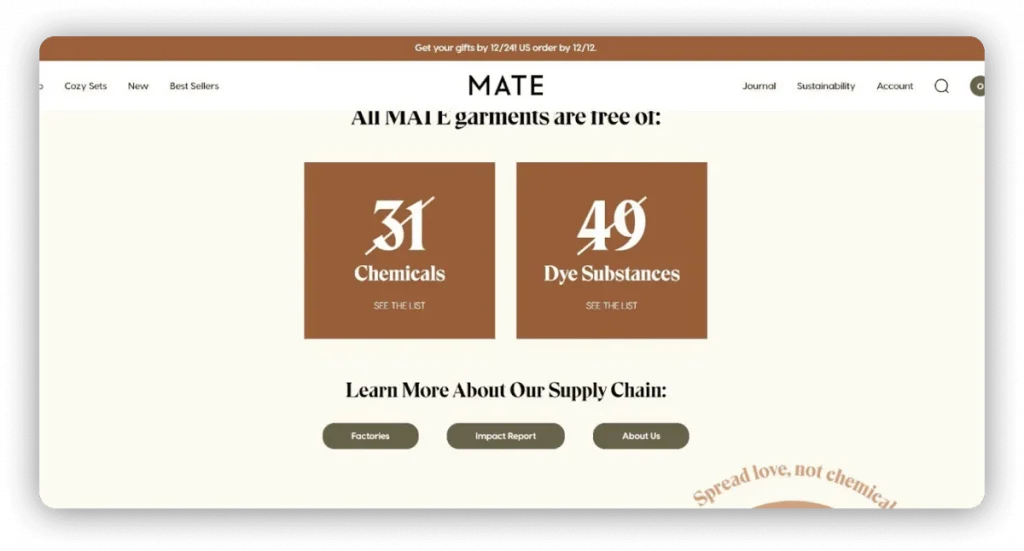
Like Zulu & Zephyr, Mate the Label discusses their supply chain on their front page. They also mention keeping their garments “organic, essential, and ethical.” Overall, their homepage makes it clear to consumers they are passionate about ethics, sustainability, and being environmentally friendly.
How to Build a Transparent Brand
Transparency is a value and a commitment, but it’s also the culmination of various practical activities. Here are some simple steps that brands can take to be more transparent in their day-to-day operations:
#1. Be Honest in Communications
Whether through an internal memo, blog post, or product description, transparency is created when communication is honest, authentic, and straightforward. For example, don’t use stock images of happy workers on the website’s team page; use shots of real employees. Make sure to provide accurate product information, including sourcing, materials, sizing, and more.
Everlane, an online shopping site that talks about “radical transparency,” is a great example of how brands can effectively implement transparency. Every product description includes the factory’s name and a link to a page displaying information and images from the factory itself. This access to supply chain and sourcing information is an incredibly powerful way to combat consumer perception of unethical manufacturing practices.
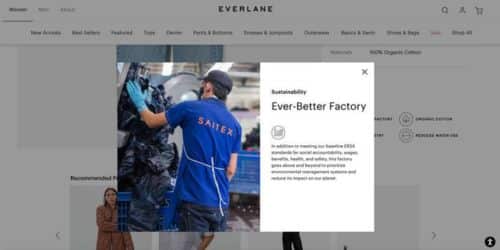
#2. Use Social to Talk Directly to Customers
Social media is possibly the most transparent channel today since it facilitates direct communication between brands and their customers, with no middleman or third party skewing the message. A full 81% of consumers believe that social media has increased accountability among businesses. The best business pages on social media are proactive about talking to consumers, offering relevant, useful information, and responding to queries and feedback, even when negative.
Delta Airlines’ Facebook page is a great example. Among weather warnings and videos about how the airline works behind the scenes, almost every post draws customer comments and complaints, and the airline responds to each one. Not only does this provide good customer support, but the interactions are open and transparent, demonstrating to everyone who sees the page just how much the company is willing to face its customers and attend to their needs.

#3. Promote Honest Feedback

Businesses and brands already know that to grow, they need to be honest with customers. This means providing platforms for customers to give raw, unfiltered feedback about products and services. Long gone are the days of fake reviews and star ratings. Companies like Amazon have processes to determine whether a review is verified, while the feedback and rating function of social media business pages means that brands can’t hide behind anonymous reviews. Customers can put their name and face to their statement, which makes it that much more authentic. Brands shouldn’t shy away from providing platforms for honest customer feedback. Even bad reviews can have a positive impact if the company is transparent about what they are doing to fix the problem or compensate the customer.
#4. Be Honest About Pricing Practices
Customers understand that, at the end of the day, you’re running a business. Making money is necessary. Although satisfying the customer’s needs and desires must remain your top priority, you have obligations to internal and external stakeholders, too.
Even a simple (but direct) explanation about how you price your products and/or services does wonders for establishing trust with customers. It also helps you retain more customers when pricing changes. For example, when Netflix raised the prices on their subscription service, they were straight up with their customers: “Prices are being updated so that we can continue to offer more variety of TV shows and films” (theverge.com).
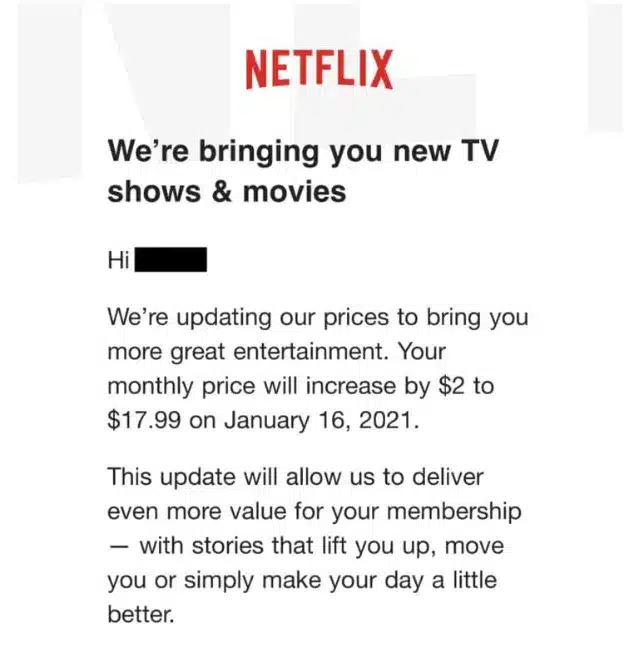
#5. Implement Clear Data Practices
Imagine trying to navigate a city with a decade-old map—streets have changed, new buildings have appeared, and old landmarks have vanished. This is what it’s like using outdated or inaccurate customer data in today’s fast-paced business environment. However, maintaining your data isn’t just key for creating seamless, personalized experiences – it’s also vital for building trust with consumers.
Transparently communicating your data management practices and privacy measures to customers reassures them of your commitment to safeguarding their information and maintaining data integrity. So, broadcast these processes loud and clear. Mention explicitly how data will be used when you’re capturing customer data through pop-ups and sign-up forms, and have a robust, easy-to-locate privacy policy on your website for customers to check out exactly how, where, and why you will use their personal data.
Creating a Brand Transparency Strategy
Today, brand transparency is a necessity. Consumers are more informed than ever and demand openness and honesty from the brands they support.
A robust brand transparency strategy is essential for building trust, stimulating loyalty, and driving business growth. But how can a brand ensure its transparency strategy effectively resonates with its target audience? Below I have provided a comprehensive brand transparency strategy checklist to guide you through.
Creating a Brand Transparency Strategy Checklist
The Future of Brand Transparency
As customer expectations continue to evolve, brand transparency is set to evolve with them. In fact, several key trends are already beginning to emerge:
Trends shaping the future of brand transparency
- Blockchain integration: Blockchain’s reach is set to expand, with technology being used in supply chain transparency. This will give consumers a watertight way to track their products’ journeys, from sourcing and manufacturing to their hands.
- Consumer-driven initiatives: Consumers will increasingly hold brands to higher standards, with crowdsourced audits and public ratings empowering shoppers to hold brands accountable. This next-level transparency will foster a new culture of openness and continuous improvement.
- Digital marketing transparency: Trends like ad verification and influencer disclosure guidelines will drive greater honesty in marketing, helping consumers make informed decisions and trust brand communications more.
Final Thoughts
Transparent brands are no longer just a buzzword, but a necessity for businesses that want to gain and maintain their customers’ trust. Customers are demanding more information and accountability from the brands they support, and companies that prioritize transparency are more likely to succeed in today’s digital era.
It is essential for building trust with customers, differentiating from competitors, and maintaining a positive reputation. It allows brands to stand out in a crowded marketplace and attracts consumers who are looking to make a positive impact with their purchases.
Similar Articles
- Employee Branding in 2024: Top 9 Trends No Company Can Ignore (According to Experts)
- Branding Sentiment Analysis: Everything You Should Know
- Employee Branding in 2024: Top 9 Trends No Company Can Ignore (According to Experts)
- How to Protect Your Brand Online & Offline (Expert Tips)






